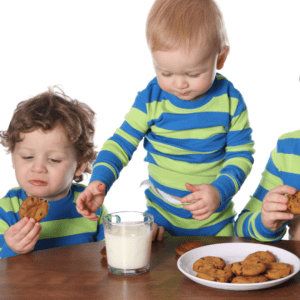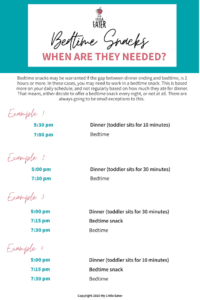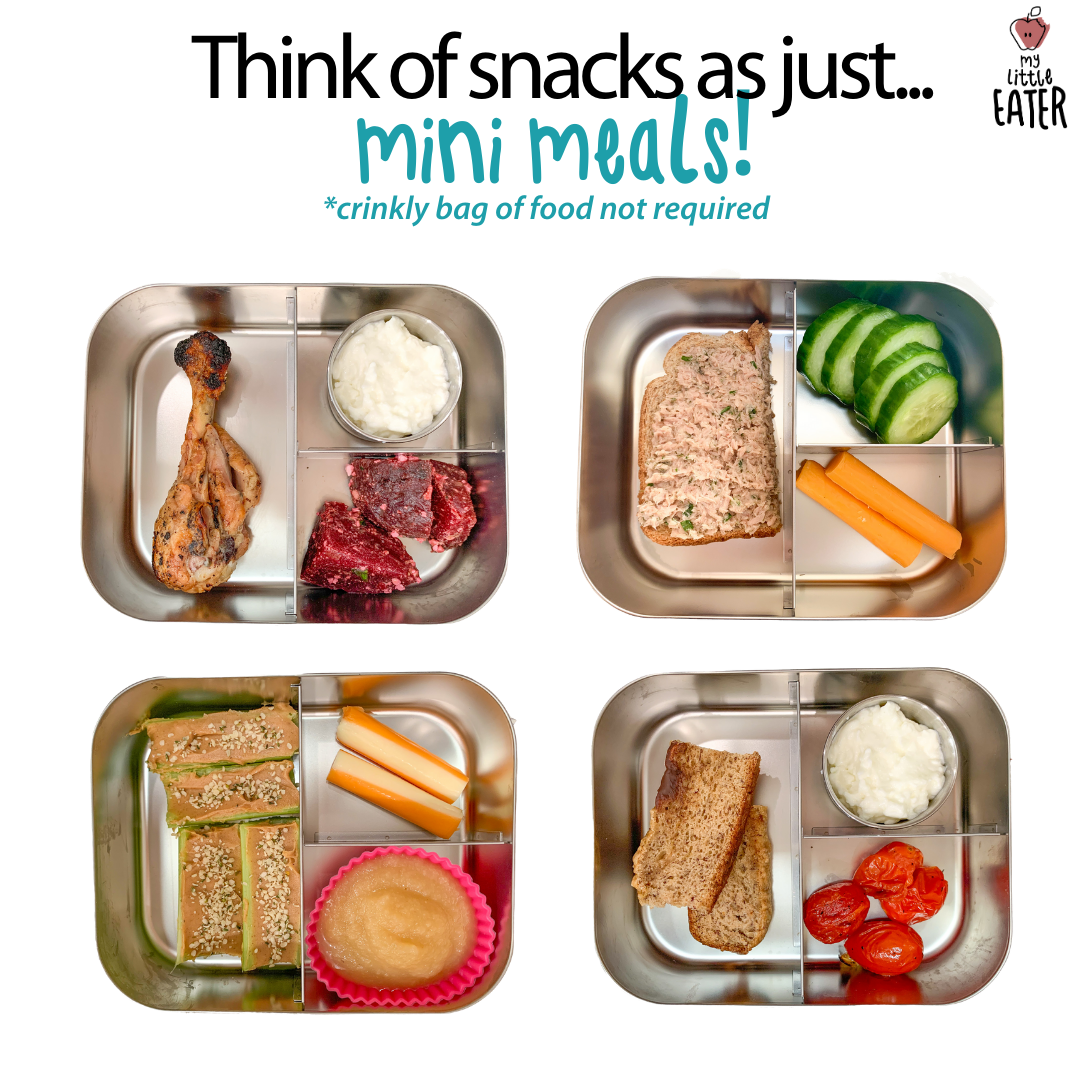
Bedtime snacks – yay or nay? I get this question A LOT on Instagram when I do my weekly Q&A Wednesdays. We’ve all had our toddler proclaim seconds after being told it’s bedtime, “But I’m hungryyyyy!” So, what’s the deal? It’s time for me to lay this all out for you, because the truth is, it’s complicated. They work well for some families, and cause some pretty frustrating repercussions for others. So, let’s just jump right into the juicy details of the greatly coveted (by toddlers anyway) bedtime snack!
What’s the purpose of a bedtime snack?
I’ve heard a lot of things when it comes to bedtime snacks over the years. From “What food can I offer at bedtime to make my toddler sleep all night?” to “Well, my toddler refuses to eat dinner so I have to offer a snack before bed, right?” So, let’s first talk about the purpose a bedtime snack should, or shouldn’t, serve.
There’s no food that I can suggest you serve to make your toddler sleep all night. It doesn’t exist. I will never suggest you feed your toddler in an attempt to make them sleep. For toddlers, food is offered on a schedule, and they eat it if they’re hungry when it’s offered. That’s it. You can’t make your toddler eat a specific snack, or a specific amount, in the hopes that they’ll sleep longer at night, especially if they aren’t hungry when you offer it to them in the first place. If your toddler isn’t sleeping well, or isn’t sleeping all night, and has an appropriate feeding schedule where well balanced meals/snacks are routinely offered, it’s not a food issue…it’s a sleep issue!
Secondly, a bedtime snack is not a backup plan for a supper that gets refused. If your toddler doesn’t eat their dinner, it’s their choice and they can/will learn how much they need to eat to fill up for the night (need help with this? Check out my Feeding Toddlers online course). We need to trust them to do this and respect their choices at mealtime. So if you don’t regularly offer them a bedtime snack, then don’t offer them one just because they didn’t eat dinner. I’ll be talking about this more in a little bit.
Bedtime snacks are solely for the purpose of feeding your toddler because they’ve built up a true appetite before bed. Whether or not they get a bedtime snack is based on when their last eating opportunity was (ie. dinner), and when their bedtime is. You need to look at the timing of these two things to determine if it’s necessary to offer one. Don’t worry, I’ll be showing you how to decide!
I also want to make a note about offering milk before bed. Ideally, if you were formula feeding, you’ve made the transition from formula to milk, or a milk alternative, and have weaned off of bottles, or are in the process of weaning off bottles. Regardless, I want you to remember that milk is a food. It has nutrients and calories. Which means, if you’re still offering a bottle of milk at bedtime, that is a bedtime snack. If you decide that you want to be including a solid food snack for them as well, after reading this full post, then I would offer both of these simultaneously – not as two separate eating opportunities.
Why I don’t always recommend a bedtime snack
I’m not necessarily a fan of bedtime snacks for all toddlers unless, based on your schedule, it’s necessary for your child to get another opportunity to eat before bed. I don’t recommend offering them if that isn’t the case, because they can quickly become a “bedtime trap”, and this is true for two reasons.
Reason #1: Your toddler may choose to skip dinner in favour of their bedtime snack
I’ve heard many times from families that they don’t know what to do because their toddler will state that they aren’t hungry at dinner, and will refuse to eat anything more than just a couple of bites. BUT, then when they’re offered a bedtime snack, they devour it in record time and keep asking for more.
Toddlers are smart. They pick up on things quickly, especially schedules and routines – so they know what’s coming up! If they know they always get offered a bedtime snack, and especially if they know that snack will be made up of some of their favourite things – think goldfish crackers, cookies, granola bars, etc. – they’re going to skip dinner to get to the “good stuff”. Especially if that dinner includes something new, or something that they’re still learning to like. Why bother trying something they’re unsure of, or that’s a little more challenging to eat, when they know they can say they’re not hungry, mom and dad won’t make them eat (which is awesome by the way!), and they can fill up on a snack before bed? I’m not gonna lie – I would do this too!
Reason #2: Your toddler could use it as a way to stall bedtime
Just when you think you’ve got them settled down for bed, you kiss them goodnight, you turn off the lights, you hear it…. “I’m hungry! Can I have a bedtime snack?!” Like I said, toddlers are smart. They know that if they say they’re hungry, you’ll give them a snack. If you’re not choosing the feeding schedule and sticking to it, you’ll leave lots of room to wonder…is my kid actually hungry or is this just a stall tactic?
When are bedtime snacks warranted?
As I’ve mentioned a couple of times already, bedtime snacks may be necessary when your toddler’s schedule dictates one be offered. I’m going to clarify this one now. If the gap of time between dinner ending and bedtime is 2 hours or more, then a bedtime snack is warranted to include in your feeding schedule.

Bedtime snack tips to keep in mind
#1: Snack is always served OR snack is never served
There’s no in-between on this. If you choose to serve a bedtime snack, you’ve made a decision to add it into their feeding schedule, and therefore it should always be there. Just like a morning or afternoon snack would be. It can’t be served as a backup when they don’t eat their dinner, and it can’t be offered just because they ask for it, or say they’re hungry before bed. Snacks are on the schedule because YOU decided to put them there, not because your child asked you to add them.
#2: Snacks should be offered at the table, just like meals are
This is true for all snacks, it’s really the safest way for them to eat, and helps prevent choking. But, especially for bedtime snacks, I really want to make a point of this. Bedtime snacks should not be provided for your toddler to take up to bed with them and eat before falling asleep, and so that would mean no bottles of milk in their crib either. Toddlers should really be brushing their teeth after eating their snack, and before going to bed, to prevent cavities forming from the sugars in food staying on their teeth.
#3: Bedtime snacks should be no longer than 15-20 minutes
Let them know that they have 20 minutes for their bedtime snack, and then it’s time to start their bedtime routine. Whether that’s having a bath, brushing their teeth, whatever will be coming next. If you think it’s necessary, or that it will help your toddler make that transition, you can set a timer. If they ask for refills during this time, provide them with more. If they ask once the timer has gone off, then you can let them know that snack time is over now, they’ll have more time to eat at breakfast, but for now it’s time to take a bath, or whatever that next activity is. There’s no need for snacks to be long and drawn out, or you risk falling into the trap I mentioned above – ie. bedtime snacks being a stall tactic for bed.
#4: Bedtime snacks should be filling…but not thrilling!
We all know how much kids love their typical “snacky” foods (think goldfish, granola bars, cheese strings, yogurt tubes, etc.) and how much more appealing those are compared to the dinner you served them not long ago. If you keep your bedtime snack options a little less exciting, then it reduces the chances that they’re asking for a bedtime snack just to get at those coveted foods, and perhaps not eat their supper in favour of these. So try to exclude any typical treat or “snacky” foods, and instead make bedtime snacks (and ideally, most of your snacks) mini-meals! Of course, “snacky” foods may happen once in a while. But as with every other meal and snack, you want to keep offering variety, and switch things up from day to day, so they don’t learn to expect a specific bedtime snack.

Also, in order to keep the snack filling, you’ll ideally follow my FFP rule for snacks – have 2 of either Fat, Fibre, or Protein included in the snack. This ensures the snack will keep them full, and it will help keep their blood sugar levels balanced.
Are there any exceptions to these rules?
Inevitably, whenever I explain my thoughts on this, I get follow up questions asking about specific scenarios, so I want to cover those next.
Scenario 1: “My toddler sometimes comes to me and says they are SO hungry and can’t go to sleep because their tummy hurts. Shouldn’t I give them a snack then?”
Of course there will be times when your schedule was thrown off, it was a stressful day, and perhaps your toddler didn’t get the chance to eat much in a proper environment earlier, leaving them actually truly, so, so hungry. The thing with this scenario is that it has the potential to snowball. By that I mean, at first this happens so infrequently, so you give in and offer a snack. But then, slowly, it starts to happen more and more, until all of a sudden they’re begging for one every single night. That’s the thing with making exceptions. When you do it once, you have to be prepared for the fact that it will come up again. Ideally, you should be the one deciding to add in bedtime snack, not your toddler. So if you’re experiencing this scenario, I urge you to take a look at your schedule…
How spread out are their current feeding opportunities?
Is there more than a 2 hour gap from dinner to bedtime?
Determine whether they need a bedtime snack. If they do, add one in before they begin asking more and more until they think it was their idea, not yours. If they don’t, be prepared to hold that boundary with them the next time they ask. They will learn, with time and practice, that they need to be eating more at dinner to make sure their tummy feels full when they go to bed.
Scenario 2: “I don’t offer bedtime snacks, but sometimes my toddler wakes up so hungry, what do I do? Do I offer them food in the middle of the night? I feel bad!”
Again, always room for the random exception on this, but ideally, no. My suggestion would be to empathize with them, and let them know that food will be available in the morning with breakfast, but that the kitchen is closed right now. A little bit of hunger won’t hurt them, and just like in the past scenario, they will learn that they need to eat more at dinner to stay full at night. You could say something like…
“I understand your tummy hurts, that’s how it feels to be hungry. We’ll have breakfast in the morning to fill you up. Let’s start trying to check in with our tummies at dinner to make sure they’re full before we stop eating.”
If you’re finding this scenario is coming up fairly frequently for you, it’s time to re-evaluate their schedule and determine if a bedtime snack is needed.
I’ll also say that with this scenario, you’re going to want to consider whether or not your toddler is using this as a tactic to spend time with you, cuddle with you, come to sleep in your bed, etc. So if you find that their feeding schedule looks good and a bedtime snack isn’t warranted, you’ll want to evaluate what else may be going on. Are they scared? Do they just want to be with you? Are they having trouble sleeping? Sometimes toddlers don’t know how to express what it is they’re feeling or what it is they need, so they go for something they know you’ll react to. Sometimes we have to play detective a little bit to help determine what’s really going on!
Bedtime Snack Ideas!

Okay, so if after all of that, you’ve taken a look at their schedule and have decided that your toddler should have a bedtime snack – what do you feed them?
Here’s a list of some of my favourite ideas…
- Leftovers
Note: this is only cool if it’s not done as a form of punishment. It’s not like you’re saying “Here, you didn’t finish your supper, so you have to eat it now since you didn’t eat it then.” Maybe there’s some of their dinner left from the previous night you saved, and could use now for a bedtime snack. Or, maybe there’s a way to repurpose the dinner they just had to make it seem slightly different. For example, if you served chicken, broccoli, and rice. Maybe take a couple strips of chicken and broccoli, and roll it up in a tortilla with a bit of plain Greek yogurt. You could serve them half of the wrap to start, and let them ask for the other half if they’re still hungry.
- Toast with peanut butter and bananas
- Hard boiled/fried egg and sliced peppers
- Toast with butter and a slice of cheese
- Classic cheese and crackers
- Oatmeal with hemp seeds
- Full fat yogurt with applesauce stirred in
- Half a bagel with hummus
- A muffin and a slice of cheese
- Serving of fruit (whatever you have on hand) and a glass of milk
- Shredded meat (pork, chicken, turkey, etc.) and cucumbers
- Edamame beans
For more mess-free ideas (because who wants to clean up a big mess before bed), check out my blog on baby led weaning while traveling for inspiration!
If you want a bigger list of snack ideas, and meal ideas too, along with my complete step-by-step process for feeding you toddler, enroll in my Feeding Toddlers online course! I provide you with all of the nutritional considerations you need to know when feeding your toddler, along with a complete guide on how to lay a good foundation to prevent and overcome picky eating. Start today!





